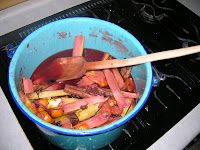
We, meaning my handsome assistant and I, consider ourselves now to be truly culinary geniuses after pulling off this amazing, seemingly authentic stew the other night. This locally worshipped soup is super (Hah!) nutritious and great for warding of the sharp chill of these colder January nights. I recently was reading about how much more vitamin C a chile poblano has versus an orange. The article stated that only chiles de habañero and strawberries have more per serving.
Anyway, my faithful assistant and I were determined to master this culinary staple of Michoacán, which is shared by neighboring states of Guerrero and Jalisco among others. What is fun about this dish is that it's regimented as an evening meal. The later the better. Pozole is ladled piping hot out of street vender's carts and mother's kitchens alike to warm people up as they celebrate outside for festivals throughout the fall and winter, like Noche de Muertos, Nochebuena, and the Posadas, nativity plays, held in all the neighborhoods before Christmas.
Our recipe and experience making this widely reknowned dish is worth noting, mostly because I like the flavor we coerced from our raw ingredients more than other pozoles I have sampled lately. You need to stick to a basic outline for your creation to qualify as a pozole whether you are making pozole rojo, pozole verde(popular in the Southwest of the United States), or pozole blanco. I would recommend making sure you have the hominy corn, called pozolero, pork or chicken, and a decided theme with your chiles of choice. Often local pozoles rojos in Morelia feature the guajillo chile paired with chile ancho, dried poblanos. I value this combination of chiles, but the pozole has somewhat of a bite with these two, and since we were choosing to use chicken instead of pork, I feel that fresh chiles are a delicious choice for variation.
 Al Principio:
Al Principio:Chiles Poblanos (3)
Cebolla (1)
Pollito Entero
Zanahorías (2)
Cilantro
Limónes
Rábanos
After organizing the raw ingredients above, the focus is on the chicken. You need a stock for pozole, and that makes buying a whole chicken attractive because you can take a short cut and boil the bones and extra appendages after you have, as in my case, hacked away at your carcass trying to salvage most of the meat for the soup. Remind me to take a butchering course when I get home. So, anyway, we were at the horror movie stage of this cooking story, savagely abusing the dignity of the fine animal who was to be our dinner by not having the proper tools or anatomical knowledge of the beast. My faithful assistant attempted to research via internet while I was simultaneously losing the battle with the hapless bird, but I just muscled through happy to say, and we continue our story.

Remove
skin from
the chicken.
Probably not like this!
I blame my years as a
vegetarian!
We took a large, beautiful dutch oven to be our soup pot, and put all the chicken meat in first. The bones and skin were simmering away with a little salt, getting ready to be our quick stock, so it was definitely time to move on with the vegetables. Earlier I mentioned pozolero, the specific white hominy corn used in pozole. I learned from my personal guru Diana Kennedy in her excellent cooking resource My Mexico, that the pozolero I bought in the mercado, though in bulk, had been pre-treated with lime and then dissected, removing the pedicels, or seed heads of the kernels. Who is doing that? What a mind-blowingly tedious job! Well, very luxurious for us, as unbeknownst to you, reader, we had been cooking the pozolero for two hours before even starting to prepare everything else! The texture of the kernels is very tough, compared to sweet corn which you might be used to. Finally, we had the pozolero and the other vegetables prepped and ready to go in the pot.

Notice the garlic.
We diced up
six cloves and put it
in the pot too.
Also, our pozolero
was left without
water to long, but the
burned kernels
just enhanced the flavor.
The assistant was
punished accordingly.
We combined the stock and veggies with the chicken in our gorgeous dutch oven, credited to one Rose Calderone. The stock was very rich in fat and supreme in flavor. Here we added our secret ingredient to the chagrin of slow-foodies everywhere; a small can of La Morena Chipotle en Adobo! We simply liquified it in a blender and added it to the mix. I will stop here and credit Lisa Mower Sheppard of Another Day In Paradise for that brilliant idea. Otherwise, I changed so much of the recipe from her's that we won't bother mentioning it. For instance, I eliminated celery, which I would have used had I remembered to buy some! She, like many others in Michoacán, chooses to use the MSG laden Caldo en Pollo made by Knorr, which I can't stand! With chicken this cheap, you can't afford not to make your own stock!
After adding the chipotles we also seasoned with salt and pepper and added three bay leaves.

What a beautiful pot!
Thanks Rose!
The pozole needed to cook for an hour, simmering after it quickly came to a boil. I carefully washed the raw ingredients needed for garnish, some chopped white cabbage, sliced radishes, cilantro and quarted limes. You might notice the Habanero chiles in the picture; we thought we might try them with the pozole but the stew is so spicy we knew couldn't handle any more! My delightful assistant and I would definitely recommend enjoying this stew with tostadas or tortilla chips, and make sure to remember to squeeze you limes! It really makes the soup.

The attractive
assitant samples
the hearty stew!











